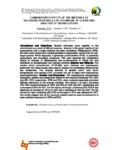Please use this identifier to cite or link to this item:
http://www.alice.cnptia.embrapa.br/alice/handle/doc/1037615| Title: | Combinatory effects of the mixtures of diflubenzuron and p-chloroaniline in tilapia and analysis of bioindicators. |
| Authors: | DANTZGER, D. D.  JONSSON, C. M.   AOYAMA, H.   |
| Affiliation: | D. D. DANTZGER, IB/Unicamp; CLAUDIO MARTIN JONSSON, CNPMA; H. AOYAMA, IB/Unicamp. |
| Date Issued: | 2015 |
| Citation: | In: CONGRESS OF THE INTERNATIONAL UNION FOR BIOCHEMISTRY AND MOLECULAR BIOLOGY, 23.; ANNUAL MEETING OF THE BRAZILIAN SOCIETY FOR BIOCHEMISTRY AND MOLECULAR BIOLOGY, 44., 2015, Foz do Iguaçu. Biochemistry for a better world: abstracts book? Foz do Iguaçu: Sbbq; IUBMB, 2015. Ref. L-15. |
| Pages: | 430 |
| Description: | Several chemicals occur together in the environment as a result of different sources. However, in the great majority of risk assessments only a single chemical has been considered. Diflubenzuron (DFB), the most used compound to combat parasites in aquaculture, can be toxic for nontarget species. When degraded, it generates p-chloroaniline (PCA), a potentially carcinogenic and mutagenic compound. This work analyzed the combinatory effects of mixtures of diflubenzuron and p-chloroaniline in Tilapia fish and alterations on phosphatases and catalase activities. |
| NAL Thesaurus: | Diflubenzuron |
| Keywords: | P-Chloroaniline Enzimes |
| Type of Material: | Resumo em anais e proceedings |
| Access: | openAccess |
| Appears in Collections: | Resumo em anais de congresso (CNPMA)  |
Files in This Item:
| File | Description | Size | Format | |
|---|---|---|---|---|
| 2015RA025.pdf | 72,58 kB | Adobe PDF |  View/Open |









